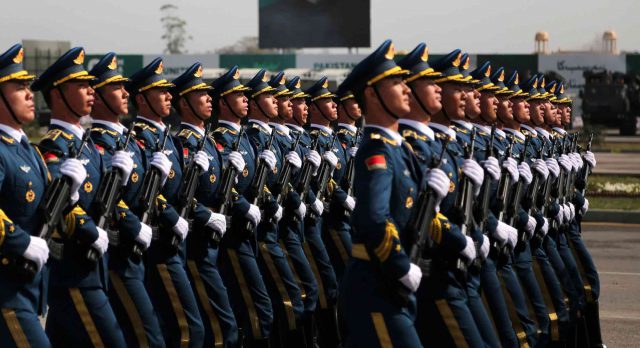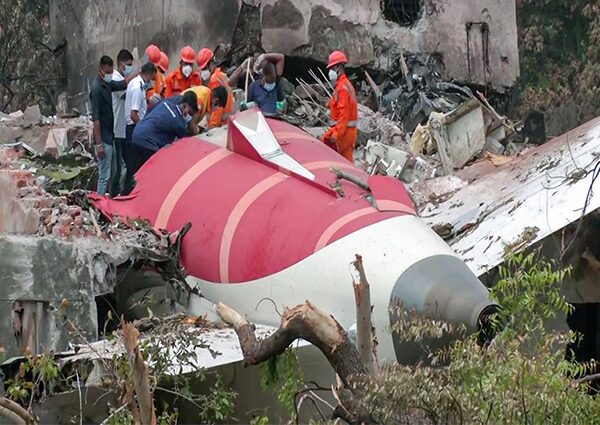
Unaffected By Covid, China’s Defence Budget Marches On
China announced its 2021 defense budget in the fourth session of the 13th National People’s Congress in Beijing. The result? A significant increase in military spending compared to a year ago, even while most other countries in the world are diverting funds into COVID-19 relief and bolstering their struggling economies.
China’s Ministry of Finance revealed on 5 March that the 2021 defense budget would rise to CNY 1.355 trillion (USD 209.4 billion), equating to a 6.8 per cent increase from last year. This firmly entrenches China as having the second-highest defense budget in the world behind the USA, though Beijing still spends less than a third of what the USA does on defense.
Nonetheless, to put it in perspective, current Chinese military spending is greater than that of India, Japan, Russia, South Korea and Taiwan combined.
It also reverses a gradual slowdown in percentage growth over recent years. Indeed, the figure of 6.8 per cent represents an increase over 2020’s growth of 6.6 per cent (total budget of CNY1.268 trillion), which was actually the lowest percentage rise since 1991. The delayed 2020 budget was announced last May after COVID-19 had swept around the world.
Furthermore, this is the sixth year in a row where China’s defense budget has experienced below 10 per cent year-on-year growth. It thus shows that China has been affected by an economic slowdown, but that it is simultaneously resilient in the rampaging wake of COVID-19.
The Center for Strategic and International Studies (CSIS) in the USA summarized: “Given that China’s defense budget has grown each year for decades, the increase in the 2021 defense budget is hardly surprising. What is more revealing are year-to-year fluctuations in the pace of growth. At 6.8 per cent, the growth rate for 2021 stands out as only the third yearly increase during the last decade. The others occurred in 2014 and 2018.
If the current rate of growth of 6-7 per cent per annum continues, China’s official military expenditure will breach CNY 2 trillion (USD 309 billion) by 2024.
CSIS added: “Spending on the military as a share of overall national government spending will rise from 5.1 per cent in 2020 to 5.4 per cent in 2021 – the highest in several years.” Furthermore, this rise of 6.8 per cent compares to a projected rise of just 1.8 per cent in fiscal spending overall for China. This confirms that the People’s Liberation Army (PLA) is a priority for Chairman Xi Jinping.
China’s financial year starts on 1 January, illustrating that the defense budget had already been decided well in advance of the NPC session. The NPC does nothing other than approve what the core of the Chinese Communist Party (CCP) has already decided.
The Finance Ministry listed an economic growth target of 6 per cent for this financial year, well below what many commentators forecast. Defense occupies 1.7 per cent of China’s gross domestic product (GDP) for 2021, and its spending per capita is less than CNY1,000. Then again, China is the most populous nation on Earth.
However, if inflation is taken into account, then China’s annual growth rate is actually less than the aforementioned nominal terms. Inflation in China has fluctuated quite a bit; since 2018 it has been slower, thus boosting defense growth in real terms. Real spending growth, when inflation is taken into consideration, was 4.5 per cent in 2018, 5.8 per cent in 2019 and 5.5 per cent in 2020. As the world starts to emerge from the surprise assault of COVID-19, inflation could rise again and thus impinge upon the PLA’s real spending till about 2025.
Under Xi, China has prioritized and accelerated its militarization, with constant remonstrations for the PLA to modernize and to boost its loyalty to the CCP. Xi is backing up his words with plenty of dosh, giving the PLA the tools it needs to threaten neighbors.
This budget is the first in China’s new 14th Five-Year Plan covering the 2021-25 timeframe. The Finance Ministry stated in its report: “We will provide stronger financial guarantees to vigorously support the modernization of national defense and the armed forces, and help China’s defense capabilities rise in step with its economic strength.”
Other buzzwords that routinely appear are “mechanization”, “informationization” and “intelligentization”, three prongs of the PLA’s modernization as it seeks to dominate the digital, cyber and networked world of military operations.
Typically, China gave no details as to how the new money would be allocated. It is estimated that approximately 40 per cent will go on equipment, both new materiel and sustaining its existing inventory.
There are apparently plans to boost some PLA soldiers’ pay by 40 per cent this year in order to attract and/or retain suitably qualified personnel. This relates mostly to officer grades. If correct, the share of spending on personnel may increase in 2021. Over the past decade, the share of spending on personnel has been in relative decline.
CSIS commented: “The announcement by the Ministry of Finance only includes the composite figure for the entire defense budget and the increase over the last budget. This figure reveals no details about specific spending priorities and likely undercounts actual defense expenditures. Compared to many countries, especially democracies, China is far less transparent about how it allocates its defense spending.”
Of course, this figure announced by Beijing relates only to its official budget. All analysts agree that the budget is actually higher, though there is debate as to how much. Supplemental funding that really should be added in are military pensions and benefits, civilian/dual-use research and development, and Central Military Commission responsibilities such as the People’s Armed Police and the China Coast Guard. Both these paramilitary organizations would support the PLA in time of war.
CSIS also noted, “Official figures also do not account for aspects of China’s space program, extra-budgetary revenues from military-owned commercial enterprises, defense mobilization funds, authorized sales of land or excess food produced by some units, recruitment bonuses for college students, and provincial military base operating costs.”
Defense publisher Jane’s believes that the real budget is some 25 per cent more than what is claimed, and that CNY 350 billion should be added to give a more accurate CNY 1.7 trillion of actual defense spending for 2021. On the other hand, the Stockholm International Peace Research Institute believes Chinese defense spending for 2019 was 38% greater than the official amount.
Incidentally, the Chinese yuan has strengthened about 8 per cent against the US dollar over the past year. Given that China does not now import so much combat equipment from other countries (historically, primarily from Russia), this will have a limited impact on expenses. However, imported raw materials and oil will be relatively cheaper for the PLA.
Premier Li Keqiang said in his government work report, “We will boost military training and preparedness across the board, make overall plans for responding to security risks in all areas and for all situations, and enhance the military’s strategic capacity to protect the sovereignty, security and development interests of our country.”
Li also highlighted major achievements in the past year in the realms of safeguarding national defense, and fighting and controlling COVID-19. In the coming year, the whole nation must “thoroughly implement Xi Jinping’s thoughts on strengthening the military; focusing on the military’s centenary goal; boosting military training and war preparedness across the board; making overall plans to deal with security risks in all areas and in all directions; and enhancing the military’s strategic capacity to protect the country’s sovereignty, security and development interests”.
Other things to be enhanced in 2021 are the structure of national defense-related science and technology industry, and the national defense mobilization system. Li also highlighted that more preference will be given to the welfare of veterans and their families.
Zhang Yesui, spokesman for the rubberstamp NPC, said China’s strengthening national defense capability “does not target or threaten any country”. He claimed China was “committed to the path of peaceful development and adheres to a defense policy that is defensive in nature”.
Yet in the past year China had a bloody confrontation with India along the Line of Actual Control, the first deaths along that border since 1975. The rollout of new equipment to units in Tibet and Xinjiang, as well as the rapid construction of new barracks, bases and facilities there, will have chewed up some of the PLA’s budget, just as it has India’s.
China’s “defense strategy” includes its legally preposterous maritime territorial claims in the South China Sea, and its lustful future conquest of democratic Taiwan. The PLA has engaged in a campaign of threatening behavior against Taiwan. However, in its maritime disputes, China is facing growing resistance from countries like the USA for its exorbitant territorial claims.
It seems that the 2020-21 budgets reflect Beijing’s effort to spread the impact of COVID-19, so next year’s budget might actually bring a slight uptick. That remains to be seen, of course. The average growth over the past five years has been 7.4 per cent.
The bottom line is that this year’s increase is China’s second-largest ever at USD 13.4 billion. Only 2014 featured a higher incremental jump, when the budget rose USD 13.6 billion. Even recent single-digit increases are higher than the double-digit growth of the 2000s. Putting this into perspective, just the increased amount in this year’s budget already eclipses Taiwan’s total defense budget of USD 13.1 billion.
CSIS concluded: “China’s substantial defense spending continues to enable the build-up of its military capabilities that pose a threat to the interests of the United States and its allies. Sustained Chinese investment in defense has shifted the military balance in the region in its favor. Moreover, the erosion of conventional deterrence vis-a-vis China has increased the risk of conflict, including the potential for a more confident and emboldened China seeking to unilaterally change the status quo through the threat or the use of force.”
This year’s budget increase from Beijing will add fuel and urgency to US Secretary of Defense Lloyd Austin’s global posture review, as ordered by President Joe Biden. That review will align the US military’s deployment with its prioritization of the Indo-Pacific region. An important component of Biden’s policy, one that is already evident, is greater cooperation between like-minded nations to stand up to China.
Admiral Philip Davidson, chief of the US Indo-Pacific Command, tweeted: “The greatest danger we face in the #IndoPacific is the erosion of conventional deterrence vis-a-vis China. We are pursuing a deterrence-in-depth posture to defend the homeland & protect our values & interests globally.” (ANI)



